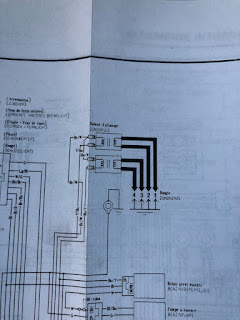Of all motorcycles from the 1980ies the one I chose to bring back was a Goldwing 1200. A 700 pound amalgamation of steel, plastic and decadence. In a sense a vehicle that most likely represents the 1980ies like hardly any other. It is a testament to a time when striving for perfection in a (touring-)motorcycle meant installing each and every gizmo possible, creating a mountain of a motorcycle that is most likely best described as either a car with no roof or a couch with two wheels.
What we have here is a 1984 Goldwing GL1200 Interstate base model. In contrast to the higher spec Aspencade it comes with an analogue gauge cluster, no cruise control and no on-board air-compressor. It should have come with conventional brakes, but instead has the non-Euro spec integral brake system of the US-models.
So we left the old girl sitting in the shed almost four years ago getting assembled from various boxes of parts into a rolling chassis, basically only needing to be wired up completely or at least to see if the engine turns over and find out a bit more about its condition.
At first glance the wiring looks very daunting and to be honest it gets kind of worse when you realise that there should be a lid on top of it all and there's actually most of the components missing.
There has to be given credit, where credit is due, whilst the whole setup is overly complex not only by 1980ies standards, it is broken down into individual modules, which can be removed (I am not going to say easily) and worked on separate from the bike, which does make the whole madness under the tank cover a lot more manageable.
Now if the routing of the spark plug cables makes you wonder a bit, it did make me wonder too at the time, but the manual clearly stated that it had to be done in this way.
Another nice thing is the cable management on the whole bike - if there's a plug, there's also a holder nearby. If not, the cables are routed incorrectly. Not so much an issue under the left side cover with only two plugs present, but a proper game changer under the "tank".
There are certain moment, when I would love to ask the Goldwing engineers what their reasoning was behind certain solutions: See this dipstick? Very nice, now look slightly to the left and a bit further up that's the filler port. My only assumption is that there were sidepanels available to essentially hide all of the engine, which would have made the filler plug inaccessible.
Using quite a few photos from the internet to find out where each component is supposed to go the space under the tank cover is now well populated and there's still quite a few spots left in those cable organizers, which is fair enough as none of the radio-equipment and the like is installed yet.
No smoke and quite a few lights doing ... something ... on the dash, but not even remotely willing to do anything at the press of a button. To cut a rather long story short, the first issue was the retrofitted sidestand switch, which had broken internally and would NOT cut the ignition in only one position and with that I mean literally only a few degrees out and it would do nothing or only very erratic things.
Then there was one plug going to the dash that was plugged in into the incorrect counterpart, but the biggest one was, the official Honda factory manual was wrong. Scroll back up, if you like, where I wrote that it looked a bit weird and not quite how I would have run the spark plug cables myself.
A quick check revealed that my suspicion wasn't all that unfounded and turns out in later editions of the same manual this schematic can be found:
Aside from the fact that one of the spark plug cables was so worn out (and too short to be trimmed any more), it was then just a case of add fuel and fire the old girl up.
It was a this point that thanks to a tip from Lars I attempted to take the back cover off from the fuel pump body and instantly found the reason, why the pump would do absolutely nothing.
What's next: Swap those spark plug cables for new ones, install the radiator and whatever is missing there. Then the integral brake system has to go in favor of a conventional setup with steel braided brake hose and whilst I am at it, the hydraulic clutch also needs a new (braided) line. The exhaust is quite a mess and so far at best half of the electrics is done, but it runs (on three legs) and it charges, so I guess the rest will work out eventually.














No comments:
Post a Comment